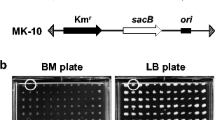Abstract
Rhodobacter capsulatus grew by using either L- or D-malate as carbon sources under light/anaerobic conditions. The cellular yields were the same with D- or L-malate. Both L-malate dehydrogenase and L-malic enzyme activities were detected in cell-free extracts from cells grown in both isomers. By contrast, a racemase activity converting D-malate into L-malate was induced only when D-malate was present in the culture medium. This racemase activity was Mn2+-dependent and was measured by coupling it either to the malate dehydrogenase or to the fumarase activities. The racemase activity was partially purified by anion-exchange chromatography.
Similar content being viewed by others
Author information
Authors and Affiliations
Additional information
Received: 30 November 2000/Accepted: 10 January 2001
Rights and permissions
About this article
Cite this article
Martínez-Luque, M., Castillo, F. & Blasco, R. Assimilation of D-Malate by Rhodobacter capsulatus E1F1. Curr Microbiol 43, 154–157 (2001). https://doi.org/10.1007/s002840010279
Issue Date:
DOI: https://doi.org/10.1007/s002840010279



